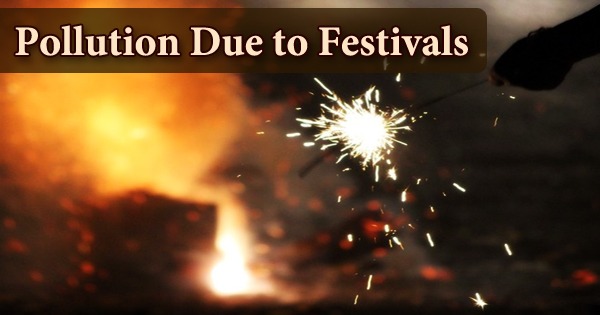Festivals used to be a time when people would rejoice and celebrate. We caught up with family and friends, ate delectable cuisine, and performed pujas at community pandals with zeal. Festivals let people feel like they belonged. We were depressed when they were finished. Don’t we simply adore it when there’s so much light and pleasure around at the festival time. India, Bangladesh, China, and other Asian subcontinent countries are diverse, and the number of festivals celebrated in these countries rivals that of any other country. However, we often overlook the fact that during festivals, we squander a great deal of material and harm our environment. It is not difficult to see how our events damage the environment. Things are definitely different in today’s world of globalization, where money is associated with joy and happiness, and religion, like everything else, has been marketed. Most festival-goers will spend a few hundred pounds and maybe end up with a bad hangover. The harm done to Mother Earth by these hedonistic gatherings might be considerably worse. During festivities, we pollute the air, water, and noise, and they have a significant influence on our health. Not to mention the animals and birds who are affected. Unfortunately, our cultural festivals have been infused with pollution, trash, and waste as a result of the present modern touch. Toxic chemicals are used in pyrotechnics, non-biodegradable plastics are used in lanterns, balloons, and confetti, and garbage is poured into rivers and landfills, destroying our world. The issue necessitates a rethinking of how we celebrate in order to strike a balance between tradition and environmental protection. The exhaust fumes of festival-goers’ cars used to arrive and exit the site are by far the largest source of carbon emissions. Individual automobile travel accounts for well over half of all types of transportation, with many events taking place in distant regions. Every year, five million gallons of gasoline are consumed during UK festivals, both for transportation and to power the event site. Diesel accounts for 85 percent of this, with the average person using 0.6 liters per day, accounting for 65 percent of the onsite carbon footprint. Every year, events create 23,500 tonnes of garbage, with 68 percent of it going straight to landfill. Single-use plastics (such as bottles, straws, meal trays, and cable ties) account for a large portion of this, as does microplastic pollution in the form of glitter and toiletry. The greatest Hindu holiday, Diwali, brings a lot of pollution with it. Cracker exploding not only pollutes the air but also makes a lot of noise. During Diwali, the air is thick and vision is severely limited. There is a lot of water waste during Holi, another Hindu holiday that is celebrated with color and water. Chemical colors are not only harmful to humans, but they are also harmful to the environment. Thousands of god idols are submerged in water during Durga Puja and Ganesh Chaturthi, polluting our waterways. The constitution gives us the freedom to exercise our faith, but it is also our responsibility as residents of the country to maintain the environment and rejoice in moderation.
What originated as communication between troops in third-century China has become a beloved celebratory ritual all across the world. Sky lanterns are commonly released during cultural events, weddings, and to commemorate loved ones. The sight of floating lanterns lighting the night sky is both beautiful and dangerous. The lanterns are composed of paper, string, bamboo, or wireframes and are propelled into the sky by a candle or fuel cell. They become a huge fire threat once unleashed. Every year, 3.17 million people travel the length and width of the United Kingdom to attend music festivals. For the great majority of them, the event is just an excuse to get away from the daily grind, let their hair down, and see some of their favorite performers in person. Few people are concerned about the environmental impact of their vices. The global effect of UK festivals, on the other hand, should not be overlooked. During some festivities, adorned sculptures are paraded through the streets and submerged in water. This technique adds a significant quantity of pollutants to our water sources. The water gets polluted and unsuitable for use when these sculptures are submerged. Because of the chemicals included in this water, it might contaminate crops if utilized for irrigation. Increased suspended particulates, particularly PM 2.5, emitted into the atmosphere by crackers are harmful to children and the elderly. They cause illnesses such as heart attacks and asthma, as well as affecting mental health. Continuous exposure of water bodies to contaminating materials causes lakes and streams to lose their purity, reducing their ability to meet people’s irrigation and drinking water demands. Several forms of diarrheal diseases, including cholera, as well as other severe infections including guinea worm disease, typhoid, and dysentery, can be spread by contaminated water. Sky lanterns are a popular ritual in Southeast Asia, however, due to their destructive nature, governments are attempting to enforce limits. Animals and wildlife are also endangered by the lanterns. Balloon releases are similarly harmful to animals, taking years to disintegrate. It’s the same as if you threw trash on the ground. The excessive waste generated during festivals has an adverse effect on the health of ragpickers and those who live near dump yards. Noise pollution has an impact on both health and behavior; excessive noise can harm one’s mental health. The first fireworks were used in celebrations to ward off evil spirits and provide luck and happiness, and they date back to the ninth century in medieval China. Fireworks are a treasured tradition across the world, used to celebrate everything from cultural festivals to backyard gatherings, and have been for centuries. PM2.5 levels between 0 and 12 are considered safe, whereas levels between 250.5 and 500.4 are considered very dangerous (it is recommended for children and the elderly to stay indoors at this level). Meanwhile, unburned propellants and colorants from the pyrotechnics that fall to the ground wash into lakes and rivers. All of these pollutants, together with the particle pollution that finally falls to the ground, represent a severe health risk to our water supplies. Festivals are a time to celebrate and be joyful. Festivals bring people together and give them a sense of sovereignty, but they also generate a lot of pollution and harm to the environment. It is also our responsibility as citizens of the country to safeguard our natural resources, as they are our riches. We must discover methods to celebrate festivals while also conserving the environment.















